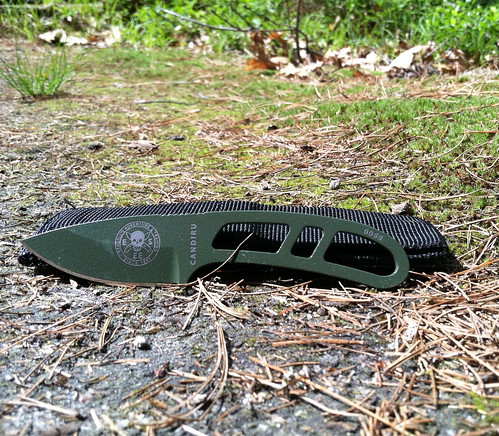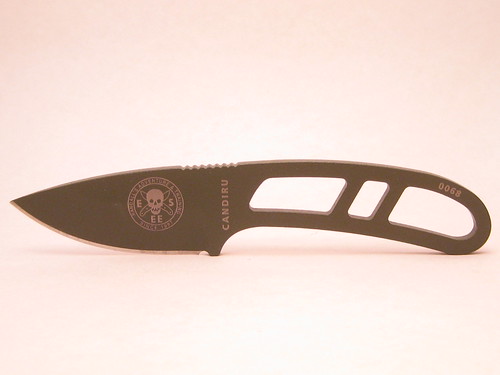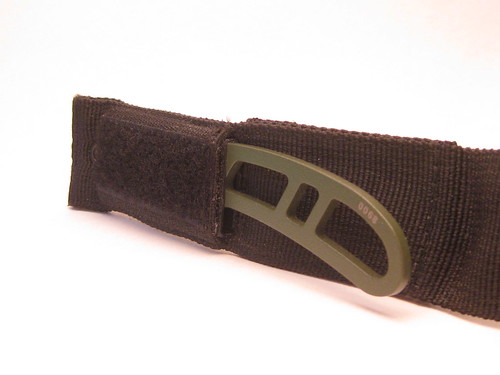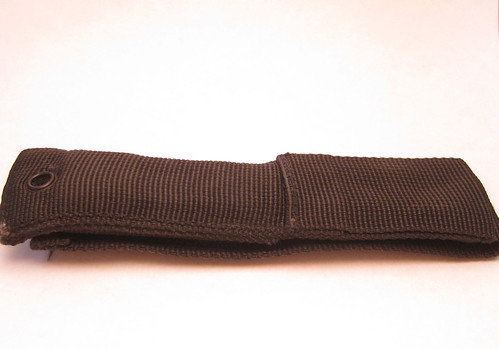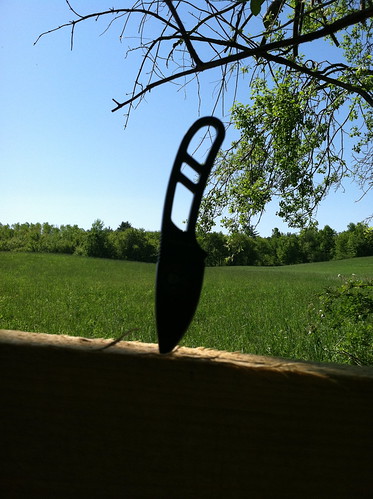ESEE Candiru Review
If the Candiru were a person, my treatment of it during the testing period for this review would have violated nearly every provision of the Geneva Convention. Suffice to say I tortured this little booger. I did the normal stuff--cut paper, cut cardboard, shave hair off my arm (which it did with ease), but I also used it like a large fixed blade. I used it to pry stuff. I cut thick plastic with it (more on that later). I cut open probably twenty wet, stinky bags of mulch. I even batonned with it. In the end, the Candiru kind of snorted and laughed at me and then asked for more. Jeff Randall and his company have done it again. They have made a fixed blade knife that can soak up hard use with aplomb.
But here is why the Candiru is so interesting. It is their first blade that can be easily and readily EDC'd. There are some competitive options that can be EDC'd too, but not as conveniently (see below for more). So the question that a consumer of gear now faces is simple--do you EDC a folding knife that can't do all of the things the Candiru can or do you carry the Candiru?
After three weeks with the little knife that could, I can say the answer is clear. I am a folding knife guy at heart. Always have been and always will be, but I can't really see the advantage of carrying a larger, hard use folder over the Candiru. In other words, as between some of the behemoth's out there, like the full sized Recon or the Adamas, and the Candiru, I'd take the Candiru 9 times out of 10. Why bother with the increased cost and size and weight of these knives when the Candiru can do all of the hard use tasks they can BETTER? Now, of course the Candiru's blade is smaller and thus the big folders may do better in a tactical role, but for me, with little reason to employ a knife tactically, I can't see buying one of these huge folders. The Candiru truly changed my perspective on fixed blade knives.
I will note, for sake of completeness, that there have been lots of small fixed blade knives, many from custom makers, but the Candiru is significantly cheaper than they are. Its not really fair to compare it to a $400 custom or even a $120 Bark River Knife and Tool. But this is a knife so good that "fair" doesn't really matter. I like the Candiru's package--its shape, size, and sheath, better than those higher end items.
I saw the Candiru around the web and decided to email Jeff Randall over at ESEE. He sent me one for review and I received a few days later. The package was incredibly small and I had original thought there was some error. But then I took the knife out and discovered that this thing is really very small, and in an EDC knife, small is a good thing. I have carried it pretty religiously over the past three weeks and we have done a lot of outdoor work and hiking so I had plenty of time to test its abilities. This is a truly great little tool.
Here is the Candiru's product page (with all of the specifications). Here is the Amazon link (with a good street price):
The knife is very new so there are no Amazon review scores. This is the first written review. Here is a video review. Here is the Candiru Jeff and ESEE sent me for testing (resting on top of a local mountain, though in Massachusetts "mountain" is different than "mountain" in Colorado; this particular hill is about 1200 feet):
For a quick refresher, here is the new Fixed Blade Scoring System.
Design: 2
The Candiru's handle and blade shape are just about ideal for everyday outdoors tasks--simple, simple, simple. It is a little odd for cutting out newspaper articles (though who reads newspapers anymore?) or other office-type chores. But in it intended role it is really sweet. I used the knife very hard and extensively for two weeks. I cut a bunch of boxes down to size. I remodeled part of my basement, using the Candiru to fit pieces of trim together. I went on three hikes and a bike ride. I batonned wood with it (yes, full on batonning, of a 1.5 inch diameter piece of dry pine). I trimmed off a rough plastic edge on one of my son's toys (ironically, this cutting/prying task was probably the hardest use). I pried a little with it during the remodeling. All of this work led me to the inescapable conclusion that this simplest of designs is also among the best. I even used it without paracording the handles (I did this to save weight).
Fit and Finish: 2
The grind on some fixed blade knives is really shamelessly bad. They figure that a hard use blade doesn't need a dainty "clean" edge, so why bother. But the Candiru came out of bag (not box) super sharp and cleanly ground. The coating was even and the stamped logos were crisp. The sheath had no stray threads, excess glue, or sloppy seams. Overall, it was significantly better than the fit and finish on the RD-7.
Blade Shape: 2
The blade is just about perfect when it comes to shape. Its gentle curve makes for a very nice belly and the grind and shape combined make for a nice tip. Here is a profile shot of the Candiru:
Nothing flashy at all, just great purposeful shape. I will note that it is similar in shape to another favorite knife of mine:
Maybe the point on the Dragonfly is dropped a bit from the Candiru, but this is very close to the elegant and high utility leaf shape that makes the itty bitty Spyderco a favorite of mine.
Grind: 2
I mentioned this before, but the grind on some lesser fixed blades is really quite awful. The grind here though is even and very clean. Also note the large secondary bevel. The cutting edge is just so good and wide that there are no problems whatsoever with sharpening. Great in an EDC knife and probably pretty helpful for field sharpening.
Steel and Coatings: 2
I am pleasantly surprised that after three weeks of pretty hard and regular use that the cutting edge is still rust free. The coating is a bit tackier than the coating on the RD-7 and vastly thicker than the normal DLC coating on cheaper fixed blades. It also feels and appears less flaky than the coating on some Cold Steel offerings. A friend lent me a SRK and the coating seemed to want to leap off the blade. It looks all cool and Boba Fett-like, but it does not instill confidence in me in terms of rust resistance. There was no flaking, chipping, or rubbing of the really excellent ESEE finish.
Handle Design: 2
At first I was worried about the skeletonized handle and hotspots. I used this knife to cut fiberglass insulation for about an hour and the handle was fine. If I were keeping it I would probably paracord wrap it but for grip and coolness not comfort. You can get a full three finger grip on the handle and I like the fact that it is not super bulky. On a knife like the RD-7, you need that bulk to both balance the knife and to make sure it stays in your hand during really strong chopping swings. This is not a chopper, it is a cutter and so with the different purpose the slender handle serves the Candiru quite well even without handle slabs or paracord. Also, if I were keeping this blade I'd probably opt for paracord over the Micarta or G10 handle slabs to keep the knife nice and slim.
Sheath Accessibility: 2
A simple flap covers the handle of the Candiru in the sheath. Once lifted, the flap reveals a knife that is really locked into the plastic liner. That keeps the knife put even through the most violent shakes I could manage. Yet, when called into duty the plastic liner releases the blade quickly and quietly with little fanfare or fight. Very, very good, especially when compared to the no hold at all sheath the RD-7 came with. That thing stinks and it is a shame because it is the exact same materials as this little guy and this thing is a real winner.
Sheath Carry: 2
The sheath is a very basic nylon sheath with a plastic insert for the blade:
It uses velcro to stay shut. It is very, very thin. I like the fact that it is this thin. There is a pass through for a belt and a eyelet for lashing. I actually just carried the knife and sheath in my pocket. It was a good change of pace carrying a knife in a sheath as it did not beat up the other occupants of my pocket. Because of its small size the Candiru in the sheath is about the same size as a Spyderco Military when closed (Candiru & Sheath: 6 inches; Military: 5.5 inches). This point is an important one. You can carry a large hard use folder in the same space that you can carry this tiny fixed blade. You get a more toughness but less reach. The implications are clear--for EDC tasks that require a bit more punch, I'd opt for the Candiru over a large folder because they occupy about the same amount of space when carried. Can't get much better than that.
Useability: 2
I am really impressed at how this knife handled some really brutal tasks. As I said above I batonned with the knife with no real problem. I also used it to cut insulation and that was a lot of pull cutting tasks. I buried the knife in the paper side of the batting and pulled through the insulation. I did this probably ten or fifteen times. Even in that unusual grip the bare handles worked well. I was wearing gloves while doing this and the Candiru worked fine (they were classic yellow leather work gloves). I would imagine that useability would improve with paracorded handles. Additionally, despite all of the cutting I did the knife still has no dings or chips on the edge and the coating looks pretty darn good (note the tiny bit of wear ahead of the ESEE logo). Excellent useability.
Durability: 2
The Candiru is not as thick as the RD-7, but it would an awful slicer if it were that thick and still this small. That said it is thicker than the Sebenza (which, surprisingly enough has a very thick blade for a folding knife, thicker than the ZT350, for example). The handle, even though it is skeletonized never flexed or bowed. The coating, as has been said already, held up well. The tip of the knife is actually quite fine and even that helped up well. The 1095 steel ESEE uses and their heat treat are quite good. The knife is still sharp (and came wicked sharp) after some serious thumping. The belly did take a bit more wear than the other parts of the blade but that is normal. It just means you have to pay a little more attention when sharpening.
Overall Score: 20 out of 20 (PERFECT!)
I worked and reworked this review twice. I spent an extra week with the blade and did some other abusive things to it just to make sure. I can't say this any other way--I loved the Candiru. I really did love it. I am not sure I could justify a large folder for EDC anyway, but with the Candiru out there it is even harder. Why carry a knife that MIGHT fail when you can carry one that CAN'T fail? I guess someone out there could make it fail but it would be in circumstances so unlikely in normal use that it is for all intents and purposes impossible. This is a truly great fixed blade--simple, sturdy, and small enough to carry with you all of the time. If you are an outdoors person or have a non-office or desk job, you should carry this knife. If you are looking for a camp knife that might make your large survival blade feel like the other woman, you should carry this knife. If you are fan of knives or penis-invading catfish (I resisted throughout the entire review, but I couldn't help it), you should carry this knife.
It is a bit pricier than the small fixed blade from AG Russell, the Woodswalker, but it is heaping gobs more stout (no doubt about full tang here) and is super slim in its sheath. There is also a Bark River Knife and Tool small fixed blade, the Pocket Bravo, that looks to compete with the Candiru, being a higher end option (in fact there are probably a dozen BRKT knives that qualify as small fixed blades). The Pocket Bravo, however, hits your wallet for more than twice the price of the Candiru and its sheath is anything but slim. Both alternatives feature stainless steel blades, but the Woodswalker doesn't look stout enough to take a batonning and keep going and the Pocket Bravo, while the same length, gets all of the portability related dimensions (weight and sheath size) all wrong. There are about a million custom fixed blades like the Candiru, but they are all more expensive.
One last thing that is hard to calculate is the fact that like Becker blades ESEE knives really become a platform for modification. There are dozens of sheathes out there and lots of different handle scales. The secondary market is just starting to make stuff for the Candiru, but once this little booger starts selling like crazy, and honestly I think it will, we will probably be treated to a whole slew of innovative things--kydex sheaths and pimp-o-licious handle scales.
This knife just about begs you to be outside. Go enjoy the out of doors and a sweet little blade.
But here is why the Candiru is so interesting. It is their first blade that can be easily and readily EDC'd. There are some competitive options that can be EDC'd too, but not as conveniently (see below for more). So the question that a consumer of gear now faces is simple--do you EDC a folding knife that can't do all of the things the Candiru can or do you carry the Candiru?
After three weeks with the little knife that could, I can say the answer is clear. I am a folding knife guy at heart. Always have been and always will be, but I can't really see the advantage of carrying a larger, hard use folder over the Candiru. In other words, as between some of the behemoth's out there, like the full sized Recon or the Adamas, and the Candiru, I'd take the Candiru 9 times out of 10. Why bother with the increased cost and size and weight of these knives when the Candiru can do all of the hard use tasks they can BETTER? Now, of course the Candiru's blade is smaller and thus the big folders may do better in a tactical role, but for me, with little reason to employ a knife tactically, I can't see buying one of these huge folders. The Candiru truly changed my perspective on fixed blade knives.
I will note, for sake of completeness, that there have been lots of small fixed blade knives, many from custom makers, but the Candiru is significantly cheaper than they are. Its not really fair to compare it to a $400 custom or even a $120 Bark River Knife and Tool. But this is a knife so good that "fair" doesn't really matter. I like the Candiru's package--its shape, size, and sheath, better than those higher end items.
I saw the Candiru around the web and decided to email Jeff Randall over at ESEE. He sent me one for review and I received a few days later. The package was incredibly small and I had original thought there was some error. But then I took the knife out and discovered that this thing is really very small, and in an EDC knife, small is a good thing. I have carried it pretty religiously over the past three weeks and we have done a lot of outdoor work and hiking so I had plenty of time to test its abilities. This is a truly great little tool.
Here is the Candiru's product page (with all of the specifications). Here is the Amazon link (with a good street price):
The knife is very new so there are no Amazon review scores. This is the first written review. Here is a video review. Here is the Candiru Jeff and ESEE sent me for testing (resting on top of a local mountain, though in Massachusetts "mountain" is different than "mountain" in Colorado; this particular hill is about 1200 feet):
For a quick refresher, here is the new Fixed Blade Scoring System.
Design: 2
The Candiru's handle and blade shape are just about ideal for everyday outdoors tasks--simple, simple, simple. It is a little odd for cutting out newspaper articles (though who reads newspapers anymore?) or other office-type chores. But in it intended role it is really sweet. I used the knife very hard and extensively for two weeks. I cut a bunch of boxes down to size. I remodeled part of my basement, using the Candiru to fit pieces of trim together. I went on three hikes and a bike ride. I batonned wood with it (yes, full on batonning, of a 1.5 inch diameter piece of dry pine). I trimmed off a rough plastic edge on one of my son's toys (ironically, this cutting/prying task was probably the hardest use). I pried a little with it during the remodeling. All of this work led me to the inescapable conclusion that this simplest of designs is also among the best. I even used it without paracording the handles (I did this to save weight).
Fit and Finish: 2
The grind on some fixed blade knives is really shamelessly bad. They figure that a hard use blade doesn't need a dainty "clean" edge, so why bother. But the Candiru came out of bag (not box) super sharp and cleanly ground. The coating was even and the stamped logos were crisp. The sheath had no stray threads, excess glue, or sloppy seams. Overall, it was significantly better than the fit and finish on the RD-7.
Blade Shape: 2
The blade is just about perfect when it comes to shape. Its gentle curve makes for a very nice belly and the grind and shape combined make for a nice tip. Here is a profile shot of the Candiru:
Nothing flashy at all, just great purposeful shape. I will note that it is similar in shape to another favorite knife of mine:
Maybe the point on the Dragonfly is dropped a bit from the Candiru, but this is very close to the elegant and high utility leaf shape that makes the itty bitty Spyderco a favorite of mine.
Grind: 2
I mentioned this before, but the grind on some lesser fixed blades is really quite awful. The grind here though is even and very clean. Also note the large secondary bevel. The cutting edge is just so good and wide that there are no problems whatsoever with sharpening. Great in an EDC knife and probably pretty helpful for field sharpening.
Steel and Coatings: 2
I am pleasantly surprised that after three weeks of pretty hard and regular use that the cutting edge is still rust free. The coating is a bit tackier than the coating on the RD-7 and vastly thicker than the normal DLC coating on cheaper fixed blades. It also feels and appears less flaky than the coating on some Cold Steel offerings. A friend lent me a SRK and the coating seemed to want to leap off the blade. It looks all cool and Boba Fett-like, but it does not instill confidence in me in terms of rust resistance. There was no flaking, chipping, or rubbing of the really excellent ESEE finish.
Handle Design: 2
At first I was worried about the skeletonized handle and hotspots. I used this knife to cut fiberglass insulation for about an hour and the handle was fine. If I were keeping it I would probably paracord wrap it but for grip and coolness not comfort. You can get a full three finger grip on the handle and I like the fact that it is not super bulky. On a knife like the RD-7, you need that bulk to both balance the knife and to make sure it stays in your hand during really strong chopping swings. This is not a chopper, it is a cutter and so with the different purpose the slender handle serves the Candiru quite well even without handle slabs or paracord. Also, if I were keeping this blade I'd probably opt for paracord over the Micarta or G10 handle slabs to keep the knife nice and slim.
Sheath Accessibility: 2
A simple flap covers the handle of the Candiru in the sheath. Once lifted, the flap reveals a knife that is really locked into the plastic liner. That keeps the knife put even through the most violent shakes I could manage. Yet, when called into duty the plastic liner releases the blade quickly and quietly with little fanfare or fight. Very, very good, especially when compared to the no hold at all sheath the RD-7 came with. That thing stinks and it is a shame because it is the exact same materials as this little guy and this thing is a real winner.
Sheath Carry: 2
The sheath is a very basic nylon sheath with a plastic insert for the blade:
It uses velcro to stay shut. It is very, very thin. I like the fact that it is this thin. There is a pass through for a belt and a eyelet for lashing. I actually just carried the knife and sheath in my pocket. It was a good change of pace carrying a knife in a sheath as it did not beat up the other occupants of my pocket. Because of its small size the Candiru in the sheath is about the same size as a Spyderco Military when closed (Candiru & Sheath: 6 inches; Military: 5.5 inches). This point is an important one. You can carry a large hard use folder in the same space that you can carry this tiny fixed blade. You get a more toughness but less reach. The implications are clear--for EDC tasks that require a bit more punch, I'd opt for the Candiru over a large folder because they occupy about the same amount of space when carried. Can't get much better than that.
Useability: 2
I am really impressed at how this knife handled some really brutal tasks. As I said above I batonned with the knife with no real problem. I also used it to cut insulation and that was a lot of pull cutting tasks. I buried the knife in the paper side of the batting and pulled through the insulation. I did this probably ten or fifteen times. Even in that unusual grip the bare handles worked well. I was wearing gloves while doing this and the Candiru worked fine (they were classic yellow leather work gloves). I would imagine that useability would improve with paracorded handles. Additionally, despite all of the cutting I did the knife still has no dings or chips on the edge and the coating looks pretty darn good (note the tiny bit of wear ahead of the ESEE logo). Excellent useability.
Durability: 2
The Candiru is not as thick as the RD-7, but it would an awful slicer if it were that thick and still this small. That said it is thicker than the Sebenza (which, surprisingly enough has a very thick blade for a folding knife, thicker than the ZT350, for example). The handle, even though it is skeletonized never flexed or bowed. The coating, as has been said already, held up well. The tip of the knife is actually quite fine and even that helped up well. The 1095 steel ESEE uses and their heat treat are quite good. The knife is still sharp (and came wicked sharp) after some serious thumping. The belly did take a bit more wear than the other parts of the blade but that is normal. It just means you have to pay a little more attention when sharpening.
Overall Score: 20 out of 20 (PERFECT!)
I worked and reworked this review twice. I spent an extra week with the blade and did some other abusive things to it just to make sure. I can't say this any other way--I loved the Candiru. I really did love it. I am not sure I could justify a large folder for EDC anyway, but with the Candiru out there it is even harder. Why carry a knife that MIGHT fail when you can carry one that CAN'T fail? I guess someone out there could make it fail but it would be in circumstances so unlikely in normal use that it is for all intents and purposes impossible. This is a truly great fixed blade--simple, sturdy, and small enough to carry with you all of the time. If you are an outdoors person or have a non-office or desk job, you should carry this knife. If you are looking for a camp knife that might make your large survival blade feel like the other woman, you should carry this knife. If you are fan of knives or penis-invading catfish (I resisted throughout the entire review, but I couldn't help it), you should carry this knife.
It is a bit pricier than the small fixed blade from AG Russell, the Woodswalker, but it is heaping gobs more stout (no doubt about full tang here) and is super slim in its sheath. There is also a Bark River Knife and Tool small fixed blade, the Pocket Bravo, that looks to compete with the Candiru, being a higher end option (in fact there are probably a dozen BRKT knives that qualify as small fixed blades). The Pocket Bravo, however, hits your wallet for more than twice the price of the Candiru and its sheath is anything but slim. Both alternatives feature stainless steel blades, but the Woodswalker doesn't look stout enough to take a batonning and keep going and the Pocket Bravo, while the same length, gets all of the portability related dimensions (weight and sheath size) all wrong. There are about a million custom fixed blades like the Candiru, but they are all more expensive.
One last thing that is hard to calculate is the fact that like Becker blades ESEE knives really become a platform for modification. There are dozens of sheathes out there and lots of different handle scales. The secondary market is just starting to make stuff for the Candiru, but once this little booger starts selling like crazy, and honestly I think it will, we will probably be treated to a whole slew of innovative things--kydex sheaths and pimp-o-licious handle scales.
This knife just about begs you to be outside. Go enjoy the out of doors and a sweet little blade.

